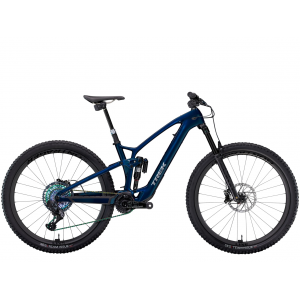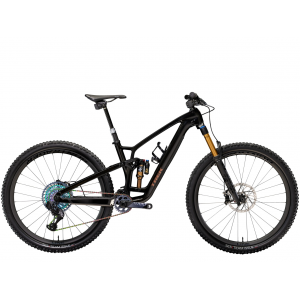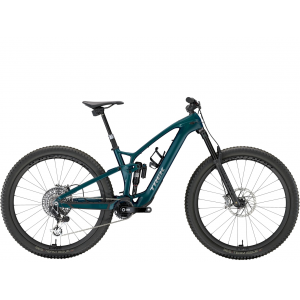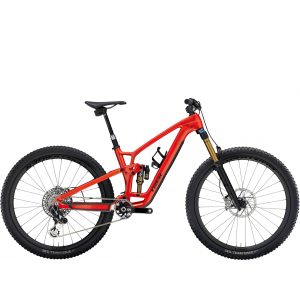2023 Trek Fuel EXe 9.9 XX1 AXS E-Bike
| Where To Buy | |||
|---|---|---|---|
Free standard shipping on all bikes (continental U.S. only).
Flat rate shipping to Hawaii and Alaska. |
Free standard shipping on all bikes (continental U.S. only).
Flat rate shipping to Hawaii and Alaska. $14,000.00
|
||
Fuel EXe 9.9 XX1 AXS
$14,000.00
|
|||
Fuel EX 9.9 XX1 AXS Gen 6
$9,749.99
|
|||
Fuel EXe 9.9 XX AXS T-Type
$14,000.00
|
|||
Fuel EX 9.9 XX AXS T-Type Gen 6
$11,000.00
|
|||
Free shipping on orders over $50 (continental U.S. only).
International shipping available. Some exclusions apply. |
|||
Free shipping on orders over $50 (continental U.S. only).
International shipping available. Some exclusions apply. |
|||

The world of e-bikes feels like it has been in an arms race these past couple of years. New models tout larger batteries and more powerful motors. Additionally, more electronic integrations, displays, and gadgets. This has left the world of lighter e-bikes in the hands of only a few players. Today, Trek does an about-face and offers the Fuel EXe - a 40-pound e-bike that to us, represents a new wave of eMTB.

Highlights
- OCLV Carbon frame
- 29-inch wheels (mixed-wheel compatible)
- 140mm (5.5-inches) of rear-wheel travel // 150mm (5.9-inches) fork travel
- ABP suspension design
- Internal cable routing
- New TQ Motor (50Nm max torque)
- 360-watt hour battery
- 160-watt hour range extender available
- Integrated display
- Accessory mounts on the underside of the top tube
- Boost 148 rear spacing with 12mm through axle
- Measured weight (size Medium, no pedals): 40 pounds (18.14kg)
- MSRP $13,999 USD as tested ($6,499-$13,999)
Strengths
| Weaknesses
|
From press releases to bike tests, Vital covers most of what is new in the eMTB world. We'd be lying if what we saw lately wasn't all that thrilling. When brands come to the market with a new e-bike, it has generally been one of two motors and a discussion about big batteries. Riders are needing ramps (as observed) or a gym membership to load their e-bikes on cars. With its 52-pound heft and all the gizmos, we got in our fair share of shots with the Trek Rail in our latest set of reviews. Like a Sour Patch Kid, the Waterloo brand has now given us a taste of something rather sweet.



In sitting through the media presentation, we were floored with what Trek and TQ were laying on the table. There were tremendous promises given with plenty of fancy tests showing how quiet the new TQ motor was. There was expansive testing in Moab as engineers from TQ and Trek collaborated to make a bike that was worth riding. Additionally, the new TQ HPR50 motor uses new technology in an unbelievably small package to deliver power comparable to other light e-bikes. As it turned out, our own test bike was physically delivered while we were watching the presentation.

The Motor - TQ HPR50
TQ may not be a brand that is traditionally known or discussed among the MTB crowd. The brand has been busy making equipment for space exploration and robotics applications. TQ's HPR50 motor was developed and is produced in Germany. The motor weighs in at 1850 grams and produces a max of 50 Nm/300 Watts of torque. TQ's battery weighs 1830g for the main unit which provides 360 Wh.



TQ Display
Trek integrated the TQ display into the top tube of the EXe and stuck with a minimalist design. There are four preset data screens (not customizable) that can be scrolled through by tapping on the one button below the screen. This is also how the bike is powered on and off. Power modes are changed via the small control unit on the left side of the handlebar. Power levels are displayed on the bottom of the screen with either zero (no assist) or one, two, or three bars to indicate the level of assist. Press and hold the up arrow on the controller to activate walk mode, press and hold the down arrow to turn off all assist.




The one display that we would have liked to have had, but is not an option, is an odometer or tripmeter. Riders will have to use their GPS unit or the Trek app in order to keep track of these numbers.

The Lineup
We know the price tag of our top-shelf test bike will make many readers wince. Despite being in line with the cost of many other e-bikes on the market, $14,000 has just not normalized as a price to pay for most people. However, Trek is offering the new Fuel EXe in a complete line that starts at $6,499 with the same OCLV frame and TQ drive system.

Fuel EXe 9.5 ($6,499) - RockShox 35 Gold, RockShox Deluxe Select+, Alex wheels with Bontrager hubs, Shimano Deore 6100 drivetrain with Shimano MT4100 4-piston brakes.

Fuel EXe 9.7 ($7,599) FOX Rhythm 36, FOX Performance Float X, Bontrager Line Comp 30 wheels, Shimano SLX drivetrain (XT mech), Shimano Deore 4-piston brakes.

Fuel EXe 9.8 XT ($8,699) RockShox Lyrik Select+, RockShox Deluxe Select+, Bontrager Line elite 30 wheels, Shimano XT drivetrain, and brakes.

Fuel EXe 9.8 GX AXS ($10,999) RockShox Lyrik Select+, RockShox Deluxe Select+, Bontrager Line elite 30 wheels, GX Eagle AXS drivetrain, SRAM Code R brakes.

Fuel EXe 9.9 XTR ($12,999) RockShox Lyrik Ultimate with AirWiz unit, RockShox Duper Deluxe Ultimate with AirWiz unit, Bontrager Line Pro 30 wheels, Shimano XTR drivetrain, and brakes.
Geometry
Though Trek's new e-bike carries the Fuel EX name, the geometry is adjusted quite a bit over its mountain bike counterpart. We're used to seeing this with e-bikes, typically in the form of longer chainstays. In the case of the EXe, it runs 440mm chainstays, about 3mm longer than the Fuel EX. It is the reach and head angle where things make a more dramatic departure. Trek is not offering a size ML (as in the case of the Fuel EX and Slash line) and instead going with some adjusted numbers and larger jumps between sizes. In the case of our medium test bike, we had a 452mm reach while the move to a large is 482mm. By comparison, the Fuel EX goes 440mm (M), 455mm (ML), and 470mm (L). Lastly, the Fuel EXe has a (by comparison) slacker head tube angle of 65 degrees (66 degrees on the Fuel EX).
Not reviewing these numbers prior to riding the Fuel EXe, we would have sworn it was longer out front than what the numbers say. While the reach figures are toward the shorter side of most bikes (while still falling in the norm), it was perhaps the seat angle and top tube combination that had the EXe riding a tad longer. On the trail, we wouldn't chalk this up as a negative, more the case of the numbers not telling the whole story. Regardless, here are all the numbers:


Setup
Our palms were a touch clammy as we triple-checked our measurements and cut lines on the $367 Bontrager RSL integrated stem/bar (star?) but the 820mm width was more than our body frame could utilize. After chopping it down to 770mm, we felt a touch more at home.



We took the Fuel EXe out for a few rides in its stock form before swapping over to a mixed-wheel setup to see how it may change the ride. Moving from the Bontrager Line 30 Pro wheels to a set of Hunt Trail Wide 30s offered us a bit more compliance on the trail. Additionally, the move to a 27.5-inch rear wheel lowered the EXe and made it a touch slacker.

Production builds of the 9.9 XX1 AXS build (tested) will come with integrated AirWiz units to help with the initial setup. These units sync with your phone via the SRAM AXS app to give a recommended pressure given the rider's weight. Our test bike was devoid of these units, which we were ok with given our experience with them on the Rail. We set our SuperDeluxe rear shock to 30% sag and kept the Lyrik Ultimate within the suggested air pressure parameters.

Because the EXe and the new Trek Connect App were both under embargo, we were not able to have access to the app. This meant we were limited to only the factory tunes that Trek sends out. It has been Vital's experience with most e-bikes, and in particular these lighter versions, that a little tuning can go a long way. Our go-to has typically been to bump up the lower power settings to make them more useable and keep the higher-powered settings only for shorter rides or times when that extra boost is really needed.

On The Trail
Our test bike was ridden by four different testers on a variety of terrain in the Sierra Mountains surrounding Reno, NV. The Fuel EXe saw a lot of action in a lot of various terrain, though all of it was very dry.
DH/Technical Performance/Fun Factor
The number one thing to keep in mind is that this is a Fuel. Not a Remedy or the latest Slash. When Trek created the Fuel EXe they undoubtedly went for the middle of the bell curve with rider appeal and trail performance. Our Fuel EXe handled descents just like a trail bike should. This is not a bike that "punches up" a weight class or rides with more gusto than it should. We're good with that. Trek created the Fuel EXe for riders to get out and explore more trails. Pushing the envelope too far may turn off much of the customer base this bike is going for.

On lower-angle downhills we found it to hold speed better than a full-sized e-bike but not quite as well as a comparable mountain bike. We appreciated the EXe's ability to pump terrain and eagerly loft the lips on various jumps. Undoubtedly this was a combination of both a "lighter" e-bike and the RockShox suspension working masterfully together.

Our Fuel EXe felt very much like a "29er" and we really felt the rear wheel in the corners. Because Trek has green-lit this bike to be run with a 27.5-inch rear wheel (via the Mino Link in the high position) we went for it. What it seemed to unlock was the EXe's more playful side. Rather than wanting to make arcs in corners, we could now push in and make faster changes in direction. Admittedly, this is also due to our tester's stature. Results will vary for riders in the 5'11" and up category but we will say for our crew, the smaller rear wheel was a subjective improvement in the bike's overall handling.

We did clarify with Trek about the effect the smaller wheel would have on the bike's governed 20mph motor. It was confirmed that yes, the bike would cut out below 20mph as the motor/speedometer would think there was still a 29er out back. The beauty of these lighter e-bikes is that we never felt the early cut-out nor found it detrimental.

Rear Suspension Performance
Trek's ABP and the RockShox Super Deluxe Ultimate made for a stellar combination. Initially, when the EXe was in full 29er mode, we did run the shock a tad soft, closer to 33% sag to get a bit more of an aggressive stance out of the bike. Despite running the shock a touch soft, bottom-outs were not harsh, nor even noticeable for that matter. Once in mixed-wheel mode, we put the Super Deluxe back to 30% sag to lessen pedal strikes.

Via the compression and rebound settings on the Super Deluxe, we were able to get some very distinct ride characteristics out of the Fuel EXe. By slowing things down a tad and lessening the compression damping, we got the bike to ride heavier and stay closer to the ground. Dialing in a few clicks of "rabbit" the EXe livened right up and was a boost machine. We enjoyed messing around with these settings and will give a nod to Trek and RockShox for making it easy to dial in the bike for a given trail or ride experience.
Unique Features
Our Fuel EXe came equipped with the Bontrager Integrated Tool System (BITS). This is not our first go with the setup. We first had it on our Slash test bike. This go-round though, we found things to go a bit smoother. Our tool did not loosen up after quite a...bit of use. (See what I did there?) Additionally, the tool was always easy to pull in and out of the head tube.


There is an accessory mount on the underside of the top tube. Something that is now rather common but merits noting. We appreciated having the necessities when it came time to do our battery-burner tests and found ourselves far from home.
AXS-equipped models have the ability to have the derailleur plug in and draw power from the bike's main battery. This is pretty awesome and is another step toward more integration. We could see this being a great backup feature should riders find themselves with a dead (or missing) AXS battery in the middle of a ride.
Geometry
Prior to launch, we really didn't have much information on the new Trek's geometry. We knew there was a 65-degree head angle but that was about it. To that end, our ride experience was unspoiled by pre-conceived notions based on numbers. Our medium EXe had a long feel to the front end when pedaling around but was not so spacious that we were stretched out. Our weight distribution on climbs was darn-near perfect.
While descending, the Fuel EXe gave us the sensation of a longer back end. This was part of why we opted for a smaller rear wheel for much of our testing period. Perhaps larger riders won't share this sensation but for us, it was a shared notion among three riders.

Perceived Weight
Our 40-pound test bike felt exactly like a 40-pound bike on the trail. In particular, we noticed this when getting back on our 31-pound mountain bike after riding the EXe. Conversely, we also noticed the weight differential after getting off a 48-pound e-bike. To that end, the EXe is successful in striking a balance between the worlds of mountain biking and e-biking.
...the Trek Fuel EXe just elevated the eMTB game.
What's The Bottom Line?
Trek has done it. They have created a lightweight eMTB that strikes the balance of power and all-around rideability. Where other brands' lighter models lack easy battery removal, the EXe line can dump the battery in a minute. Heck, it can even be ridden without it or with just the range extender. Overall power delivery is smooth and intuitive while the range is impressive. Our personal preference may be for a more aggressive bike but there is no objectivity in that claim. We have to call it as we see it and the Trek Fuel EXe just elevated the eMTB game.
Head to Trekbikes.com to learn more
About The Tester
Brad Howell- Age: 43 // Years Riding: 28 // Height: 5'9" (1.75m) // Weight: 165-pounds (74.8kg)
Brad started mountain biking when a 2.25-inch tire was large, and despite having threads, bottom brackets sucked. Riding in the woods with friends eventually lead way to racing, trying to send it at the local gravel pits, and working in bike shops as a wrench to fix those bikes. Brad has been fortunate enough to have dug at six Rampages, attend some World Cups, work in the industry for a few years, and become friends with some of the sport's biggest talents. These days, he just likes riding his bike in the woods with friends.
Specifications
Optional 160 Wh range extender battery fits into included standard water bottle cage with built-in retention strap
Display screens: battery/ride time, range/ride time, speed/average speed, rider power/motor power
Remote: TQ 2-button
Virtual length: 35mm (SM), 45mm (MD-XL)
Drop: 100mm (SM), 150mm (MD), 170mm (LG/XL)
• Geometry adjustable via Mino Link flip chip in rear rocker link pivot
• Compatible with mixed ("Mullet") wheel setups (29" front, 27.5" rear) with Mino Link flip chip in High position
• Internal cable routing
• SRAM UDH (Universal Derailleur Hanger)
• Trek Central mobile app provides motor assist tuning, range monitoring and calculation, navigation and tracking, suspension and tire pressure recommendations, pressure monitoring with AirWiz and TireWiz sensors, and integrates with third-party apps
• Includes RockShox AirWiz and Quarq TireWiz electronic pressure indicators for suspension and tires; compatible with Trek Central and SRAM AXS mobile apps
• Includes TQ 4A battery charger
• Includes tubeless rim strips, valves, and sealant
| Where To Buy | |||
|---|---|---|---|
Free standard shipping on all bikes (continental U.S. only).
Flat rate shipping to Hawaii and Alaska. |
Free standard shipping on all bikes (continental U.S. only).
Flat rate shipping to Hawaii and Alaska. $14,000.00
|
||
Fuel EXe 9.9 XX1 AXS
$14,000.00
|
|||
Fuel EX 9.9 XX1 AXS Gen 6
$9,749.99
|
|||
Fuel EXe 9.9 XX AXS T-Type
$14,000.00
|
|||
Fuel EX 9.9 XX AXS T-Type Gen 6
$11,000.00
|
|||
Free shipping on orders over $50 (continental U.S. only).
International shipping available. Some exclusions apply. |
|||
Free shipping on orders over $50 (continental U.S. only).
International shipping available. Some exclusions apply. |
|||



























































23 comments
Post a reply to: Review - 2023 Trek Fuel EXe